Experienced in Atlantic crossings, the Andrea Doria was one of the most popular liners of its time. Although not as glorified as other contemporary ships such as the RMS Titanic, the SS Andrea Doria was one of Italy’s pride and joys after World War II.
Though the Italian liner disappeared beneath the North Atlantic on July 26, 1956, its legacy lures the curious and brave to its depths year after year.
Widely considered one of the largest civilian maritime rescues in sea history, the Andrea Doria sinking is impossible to forget.
Table of Contents
What Was the Andrea Doria?
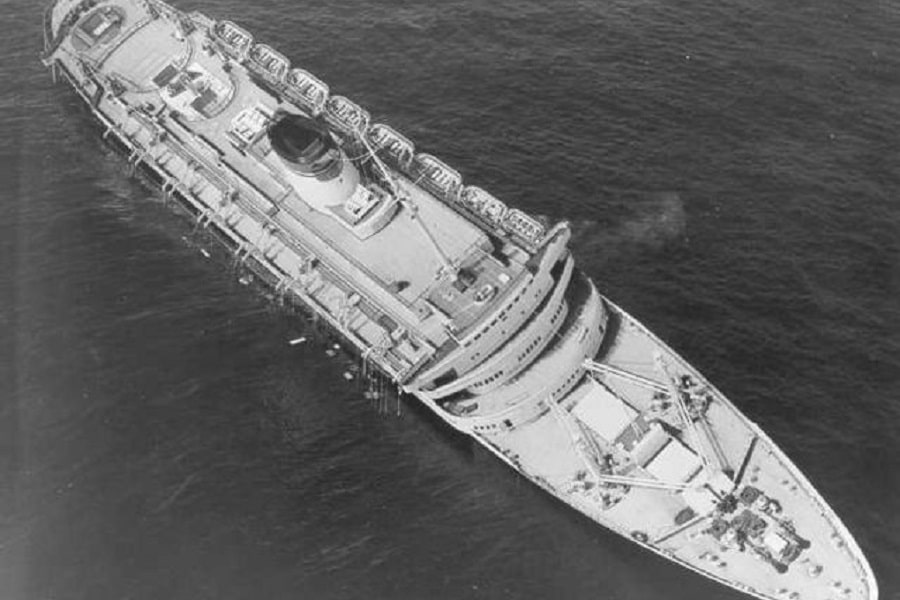
The SS Andrea Doria was a luxury ocean liner and passenger ship. It was 697 feet long and 90 feet wide at its widest point. The liner had its maiden voyage on January 14, 1953. Despite rumors of mechanical difficulties, Andrea Doria’s maiden voyage was a massive success.
The ship was named after the Genoese statesman and admiral, Andrea Doria (1466-1560). He was known as the Prince of Melfi, and the de facto ruler of the Republic of Genoa. During his time, Doria was known as being a masterful naval commander; his reputation was so well-known that the painter Agnolo di Cosimo used Doria’s likeness for his interpretation of the god Neptune.
Following the aftermath of World War II (WWII), the Andrea Doria was known as the largest, swiftest, most beautiful ship in all of Italy. That being said, the liner wasn’t the biggest or fastest of its time. Those honors went to the RMS Queen Elizabeth and the SS United States. However, the Andrea Doria was unmatched in its beauty.
As a luxury ocean liner, the Andrea Doria was given the works. Designed by the famed Italian architect Giulio Minoletti, it had three outdoor swimming pools for each of its passenger classes, tapestries, and numerous paintings. So impressive was the Doria, that it was frequently referred to as a floating art gallery. Not to mention, the ship had a life-sized statue of Admiral Andrea Doria himself!
Apart from being one of the glittering ocean liners of the 20th century, the Andrea Doria is most known for sinking in 1956. Unfortunately, the tragedy of the Andrea Doria didn’t end on the night of the sinking. Years after, companies and individuals alike would file lawsuits for damages suffered on that fateful July night.
Who Owned the Andrea Doria?
The SS Andrea Doria was owned by the Italian Line, officially called the Italia di Navigazione S.p.A. The Italian Line was a passenger shipping line that began operations in Genoa, Italy, in 1932. It continued operations until 2002.
During the Second World War, the Italian Line lost several of its ships. Those lost were either completely destroyed or captured by Allied Forces and integrated into their respective navies. Vying for a comeback in the later ’40s and early ’50s, the Italian Line commissioned two luxury ships to be built: the SS Andrea Doria and the SS Cristoforo Colombo.
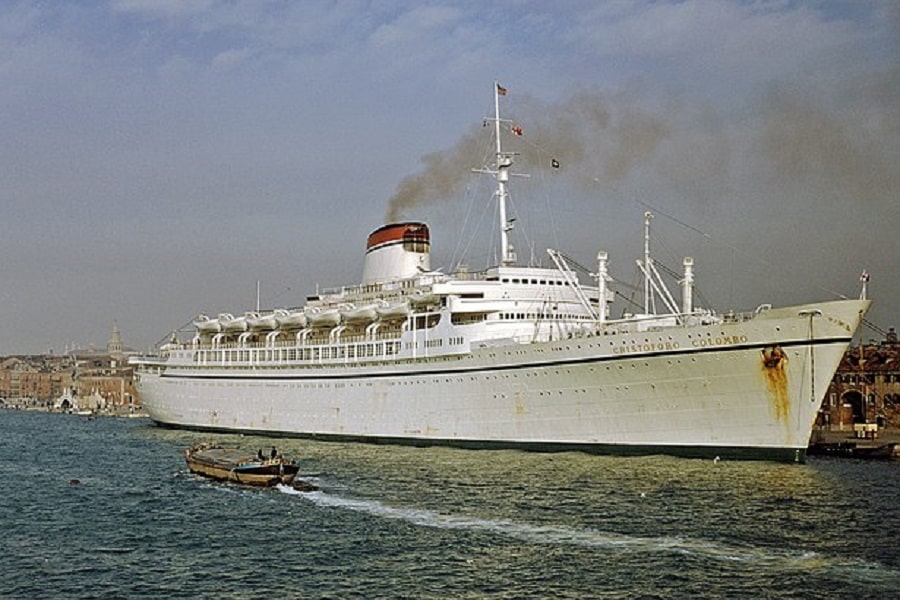
What Caused the Andrea Doria to Sink?
Poor communication, low visibility, an error in reading equipment, and an offending ship capable of breaking ice caused the Andrea Doria to sink. It is tough to say who – if anyone – was responsible for the collision. A series of unfortunate events and failed time maneuvers led to the impact.
For starters, the Stockholm was built with a reinforced icebreaking bow since the smaller liner often traversed waters near the Arctic Ocean. The damage may not have been as drastic if it were any other liner that evening, one without a bow designed to break ice floats.
Also, we have to consider command. Third Officer Carstens-Johannsen, who was at the helm of the Swedish liner, decided to change course to be slightly more southern. That way, they would be more aligned with their original eastbound route. The Doria – then westbound – did detect the Stockholm, though anticipated a passing distance of a mile.
To be fair: cutting it close, but not necessarily on a collision course. Except, Carstens-Johannsen misread the Stockholm radar and they were much closer to the other vessel than the officer thought.
Neither vessel attempted communications with the other, even though the two ships were expected to come very close in range. Since neither ship was fully aware of the other until they were too close to avoid a crash, the inevitable happened. The ships collided at 11:10 PM off the New England coast. The call to abandon the ship occurred a mere thirty minutes after the initial collision.
There is also an issue with the weather conditions, which was described as a fog wall, or a fog bank. Dense fog on the seas is a dangerous place to be, especially if you find yourself on a common travel route with outgoing and incoming traffic.
READ MORE: Who Invented the Traffic Light? A Brief History of Traffic Lights

Who was Blamed for the Sinking of the Andrea Doria?
After the Andrea Doria sank, a lot of fingers were pointed. The Italian Line blamed the Swedish-American Line, the owners of the MS Stockholm, while the Swedish-American Line pulled out an Uno reverse on the Italian Line. Meanwhile, American journalist Alvin Moscow was among the first to assert that the crash was the fault of the Andrea Doria in his account Collision Course: The Classic Story of the Collision of the Andrea Doria and the Stockholm (1959). Then there’s the point (no pun intended), that the Stockholm was the one to have penetrated the Doria.
Court litigation didn’t garner any answers, either. An out-of-court settlement was eventually reached. Each line paid towards settlements for victims and absorbed their own damages. The damages to the Stockholm were $2 million, whereas the Andrea Doria cost roughly $30 million in damages. Investigations into the incident ended after an out-of-court settlement was reached.
When looking at the facts available to the public, it is safe to say that both parties were somewhat in the wrong. Perhaps, one more than the other. Both officers in charge at the time of impact neglected to contact one another, despite showing up on each other’s radars. They then proceeded to carry out opposing maneuvers to try and avoid contact.
Above all else, it is worth considering that Stockholm neglected to operate their radar appropriately. They misread the distance between themselves and the Andrea Doria, thinking the distance to be much further than it really was. Such a seemingly minor mistake inadvertently led to the collision. Admittedly, if the Stockholm caught the mistake early on, the Doria would have likely made it to New York.
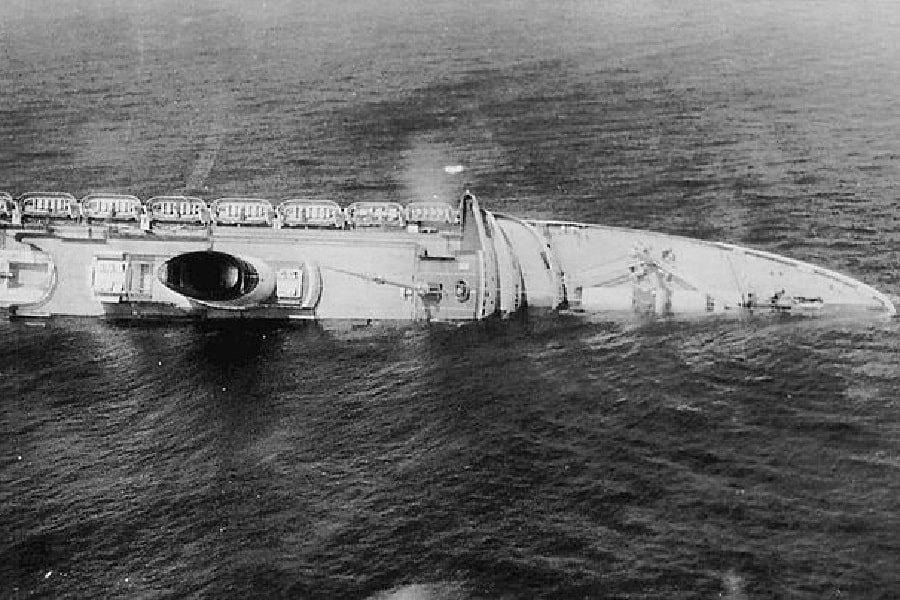
The Rescuers: SS Ile de France, MS Stockholm, Cape Ann, and Other Heroes
The efforts put into evacuating the passengers and crew of the Andrea Doria are remembered as being the greatest sea rescue in maritime history. Numerous ships and civilians pooled together to aid those on the ill-fated liner. After impact, Captain Calamai of the Doria sent out an SOS: “WE NEED IMMEDIATE ASSISTANCE.”
Ships that responded to the Stockholm-Doria crash include…
- The Cape Ann, a 394-foot-long freighter
- USNS Private William H. Thomas, a United States Navy transport ship
- USS Edward H. Allen, a United States Navy destroyer escort
- USCGC Legare, a United States Coast Guard cutter
- SS Ile de France, a French ocean liner
Almost immediately after the collision, the Andrea Doria got a severe list. “Listing” is nautical speak that more or less means a ship has a tilt to it, likely from taking on water. They were in desperate need of lifeboats and visibility, which they received an abundance of upon the arrival of respondents to their distress call.
READ MORE: Who Invented Water? History of the Water Molecule
Although the Swedish liner was involved in the crash, the MS Stockholm still aided in the rescue efforts for those aboard the Andrea Doria. Their vessel was still seaworthy despite the extensive damage to the bow of their ship. Luckily, the Andrea Doria would remain afloat hours after the collision, giving enough time for evacuations.
Most notably, the Ile de France, belonging to the French Line and one of the largest ships on the Atlantic route that evening, granted protection from incoming traffic and afforded the rescue effort illumination throughout the night. The liner, along with other ships present, offered the use of their lifeboats to evacuate survivors. As if that wasn’t enough, the Ile de France went on to harbor 753 Doria passengers on their promenade deck for the journey to New York harbor.
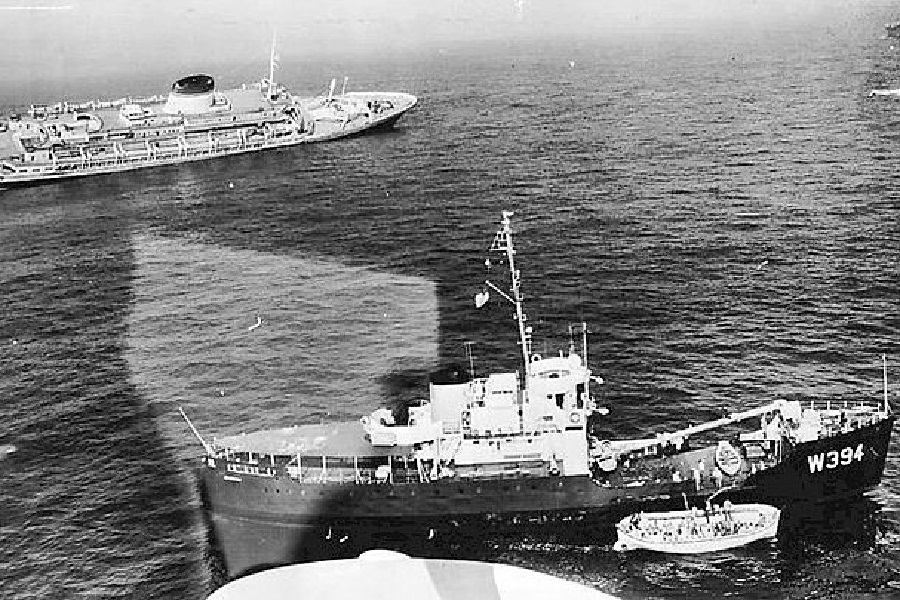
Who Died on the Andrea Doria?
46 people died on the Andrea Doria while 5 people died on the Stockholm; when we include both parties involved, the official death toll is 51. Of the three classes on the Doria (First, Cabin, and Tourist Class) the Tourist Class suffered greater casualties. However, all levels of the ship (the Upper, the Foyer, and the A, B, and C decks) where passengers were staying were affected by the collision. In all, 1,660 people were rescued and survived the ordeal.
Of the survivors, young Linda Morgan became dubbed by reporters as the “miracle girl.” The impact of the Stockholm into the starboard side of the Doria killed her step-father and step-sister but threw the then 14-year-old onto the boat deck of the Stockholm. The crew of the Stockholm found her with a broken arm, but otherwise uninjured.
Since the initial sinking, 16 people have died attempting to dive into the wreckage. Amongst divers, the Andra Doria is called the “Mt. Everest” of wreck diving. Over time, the structural integrity of the ship has deteriorated significantly. The former entrance into the wreck has collapsed, and with time the 697-foot site has made its way lower and lower into the North Atlantic.
How Long did the Andrea Doria Float?
The Andrea Doria finally capsized at 10:09 AM, approximately 11 hours after being struck by the Stockholm. For reference, the RMS Titanic sank in less than three hours and the RMS Lusitania sank within 18 minutes. With all things considered, the Stockholm–Doria crash should not have resulted in a sinking. The Doria should have been able to withstand such an impact.
Watertight compartments were sealed, though a glaring flaw in the Doria’s design meant that there was a missing watertight door that would separate the tank pump controls and the ship’s generators. Due to the location of the impact and the gaping hole left behind by the Stockholm, water surged into the Andrea Doria minutes after initial contact. That, matched with near-empty fuel tanks, meant that recovery from the list was impossible. If the list could have been corrected, the Doria could have feasibly returned to New York on its own.
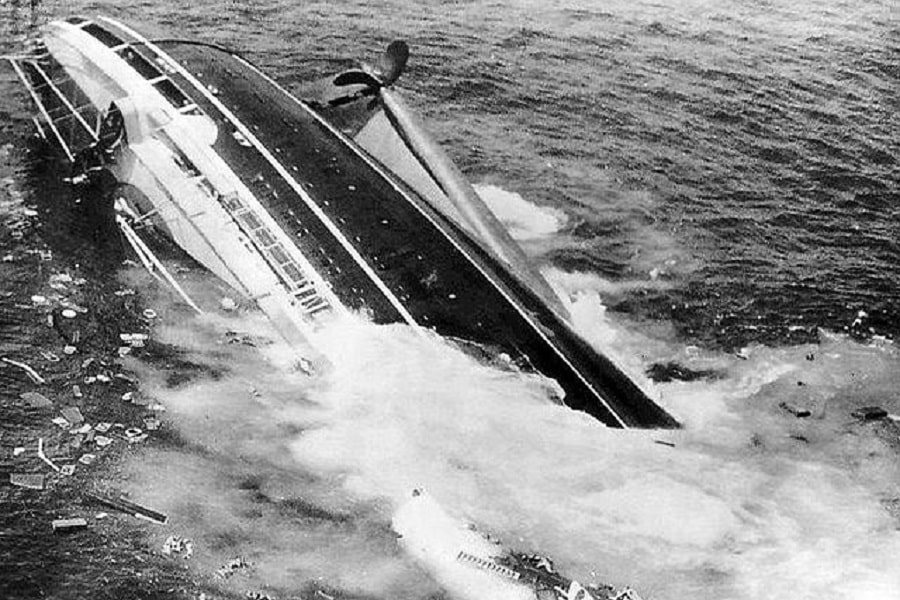
Did They Ever Find the Andrea Doria?
The wreckage of the Andrea Doria has been a popular challenge for wreck divers since its sinking. Given the scale of the collision and its notoriety, the Andrea Doria was not like the Titanic tragedy 44 years before. While the RMS Titanic was missing from 1912 until 1985, just about everyone knew where the Andrea Doria went down.
The wreck site is well-known and isn’t a maritime mystery. It actually took less than a decade after the incident before treasure divers began taking expeditions down to the capsized ship. Try within 24 hours! Despite the tragedy of it, divers began the journey beneath the waves in the hunt for the Doria shockingly quickly.
Even in the face of extensive deterioration, the Andrea Doria is still a hotspot for brave divers looking for a challenge. With each dive, new artifacts from the ship would be brought up. The bell of the Andrea Doria was rediscovered in June of 2010 by scuba divers and the foghorn was brought to the surface in 2017 in time for the 65-year anniversary of the sinking.
Is the Andrea Doria Still Underwater?
As of 2023, the wreckage of the Andrea Doria is still underwater. Regardless of such, recovery efforts have been made since the day after the sinking (we’re not joking) to retrieve the treasures of the long-lost liner. The wreck site is viewed as a challenge for passionate divers, although rapid deterioration makes the dive not what it used to be.
How Deep is the Water where the Andrea Doria Sank?
The water is 240 feet deep where the Andrea Doria sank. The ocean liner rests on its starboard side on the ocean floor. In the years following the collision, open-water divers were able to access the port side of the ship at 160-180 feet below. Over the years, the Doria has been deteriorating significantly from the swift North Atlantic currents and the port side has sunk lower than 190 feet.
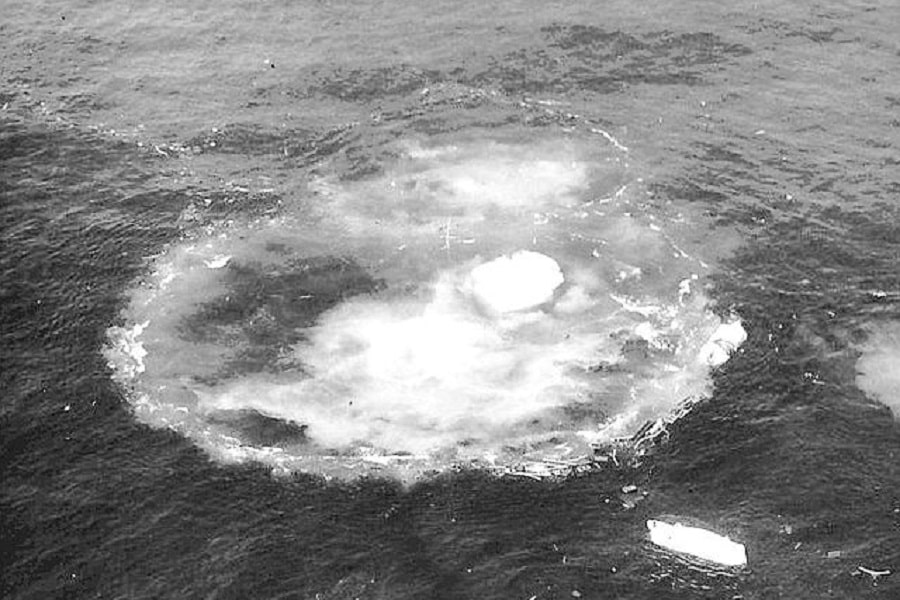
Where is the Andrea Doria Now?
The once-floating art gallery is sitting in the North Atlantic where it sank more than 60 years ago. The wreckage can be found 40 miles off the coast of Nantucket Island, Massachusetts, and 240 feet down. Although the Doria could not be salvaged, efforts have been made to recover her treasures.
In the summer of 1964, the famous bronze statue of Admiral Andrea Doria was recovered by Captain Dan Turner. Since the statue had to be cut free from its alcove, its feet and pedestal remained in the wreckage until the 90’s when John Moyer gained salvage rights to the Andrea Doria. As of 2004, the statue of Andrea Doria was returned to its homeland of Genoa, Italy following restoration.
What was in the Andrea Doria Safe?
The 3-ton Andrea Doria safe was recovered in 1984. It was rumored to hold precious stones and jewels alongside rare coins. You know, just the usual exciting myths that surround any sunken ship. The allure and mystery of the Andrea Doria’s treasures have received much attention since its initial sinking.
Peter Gimbel, an American photojournalist, had a fascination with the Andrea Doria since the news broke. He was the first to dive into the wreck a day after the incident with the photos he took being published in Life magazine later that year. Moreover, Gimbel made numerous trips to the wreckage and released two documentaries about it. In 1984, Gimbel and a team of divers (including his wife, actress Elga Anderson) located the Andrea Doria safe.
To access the Andrea Doria safe, Gimbel had to cut a hole (now called “Gimbel’s Hole”) which many divers have used to access the ship. Once the safe was recovered, a scene was made of opening it. In a very modern media fashion, cracking the safe was broadcasted on television. Though the world held its breath, the Andrea Doria safe only contained 50 $20 bills and the Italian lira.
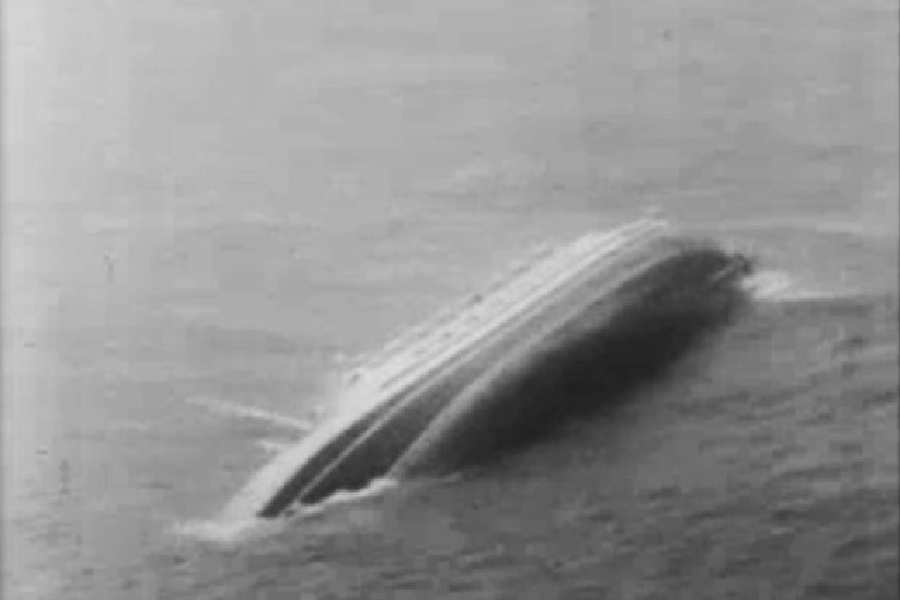
READ MORE: Seward’s Folly: How the US bought Alaska
Timeline of the Andrea Doria Sinking
10:30 PM: Carstens-Johannsen set the MS Stockholm on a southern route, unknowingly putting the Swedish liner on course to collide with the SS Andrea Doria.
11:06 PM: The Stockholm detects the Andrea Doria. Carstens-Johannsen misreads the radar as being set to a 15-mile scale; it was actually set to a minuscule 5-mile scale. Captain Calamai changes course to be further south to widen the gap of his previously estimated one-mile passing.
11:08 PM: Attempting to stay on course, Carstens-Johannsen brings the Stockholm further south. At this time, Calamai – who has been traveling in heavy fog for hours – notices the lights of the Stockholm and realizes the gravity of the situation. In a panic, the Doria’s captain turns sharply towards the south to try and avoid a collision. Soon after, Carstens-Johannsen notices the Andrea Doria and desperately tries to veer the ship away.
11:10 PM: The two ships collide. The Swedish liner hits the Doria like a battering ram. It breaks through several bulkheads, compromising the fuselage. As water rushed into the Italian liner, all electricity was lost. In all, the Stockholm penetrated 30 feet into the Doria and was missing 30 feet of its bow from the impact; the Stockholm successfully corrected its own list.
11:15 PM: SOS signals are sent out. It is the first communication either ship received from one another throughout the entire ordeal. The Doria develops a list as water pours into the starboard tanks. Attempts to correct the list were made by pumping out saltwater from the flooded tanks; the list was deemed too severe and the effort futile.
11:40 PM: Captain Calamai gives the call to evacuate the doomed vessel. It is the middle of the night and they are operating without lights. Even worse, the severity of the list means that the Andrea Doria cannot safely lower their lifeboats. Available lifeboats first had to be lowered and then accessed by Jacob’s ladders.
12-6 AM: Evacuations commence once help arrives. The largest sea rescue in history is carried out as the heavy fog lifts. Calamai was reported to be aboard a lifeboat by 6 AM on July 26th, the next morning.
9:45-10 AM: Sinking progresses as the three outdoor swimming pools refill with water. By 10:09 AM, the beautiful liner sank beneath the water. An image of the sinking liner minutes before it vanished was taken by photojournalist Harry A. Trask, for which he won a Pulitzer Prize.
Aftermath: Those ships that responded to the Andrea Doria’s distress calls made headway for New York. Survivors of the crash were scattered amongst those savior ships, causing a frenzy upon return to New York harbor. Families were separated and many eager families that showed up to gather their loved ones were distraught to discover they were missing or, worse, dead.